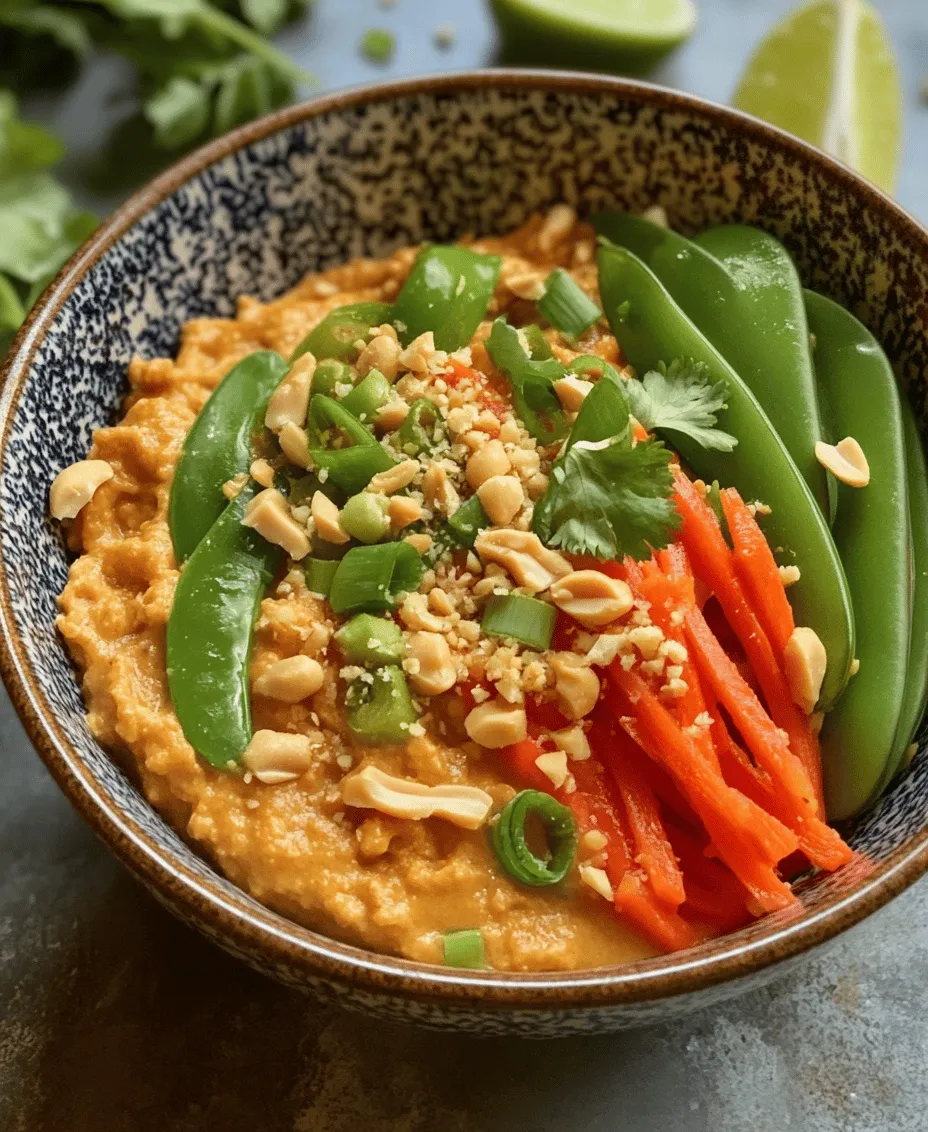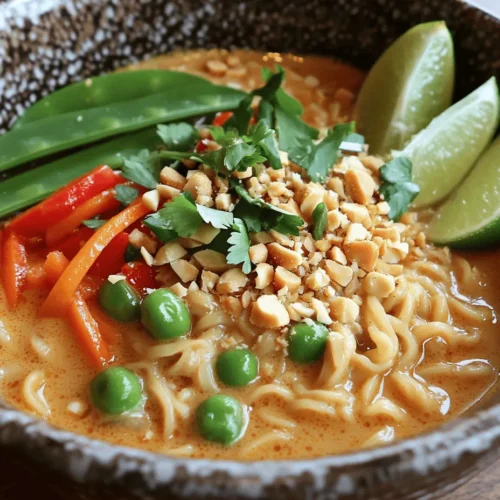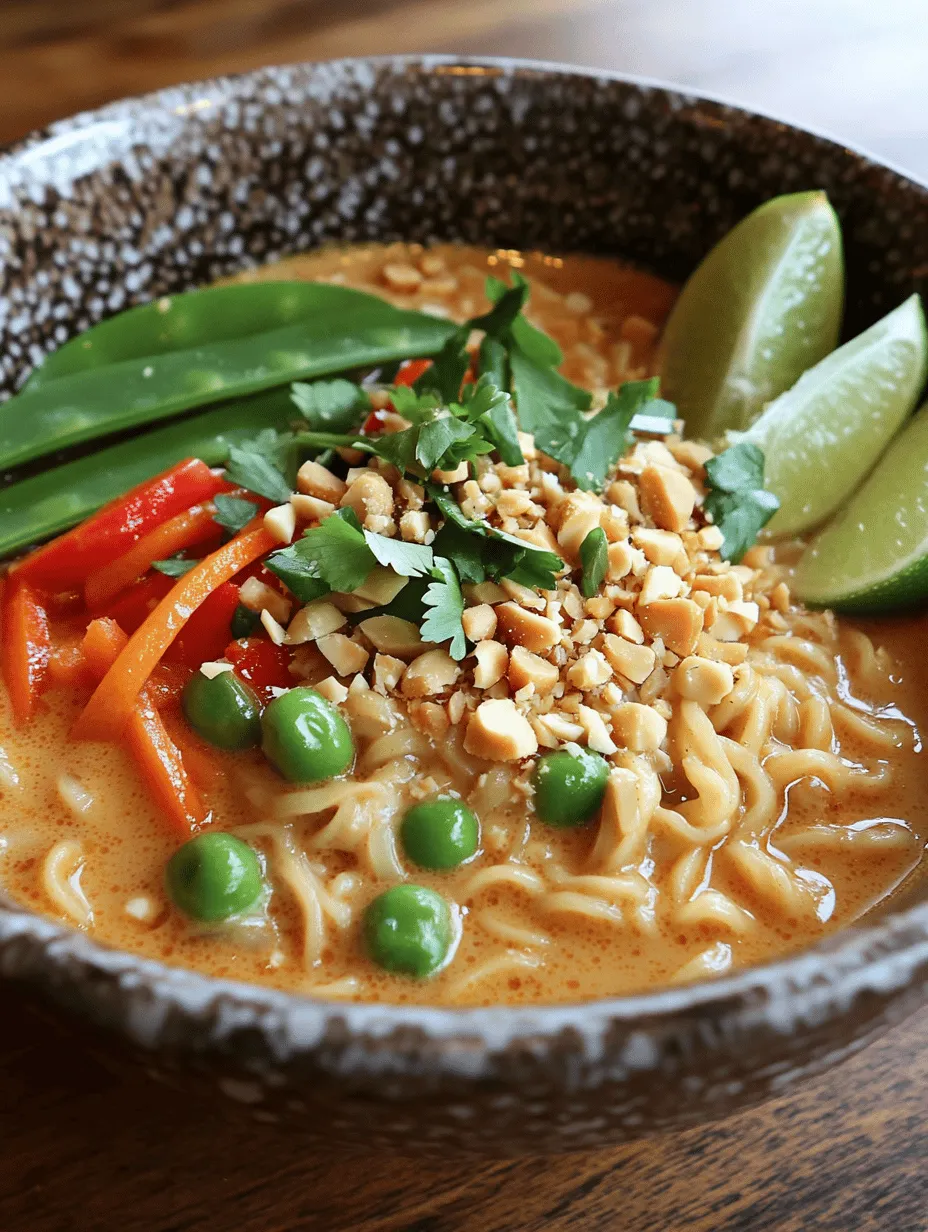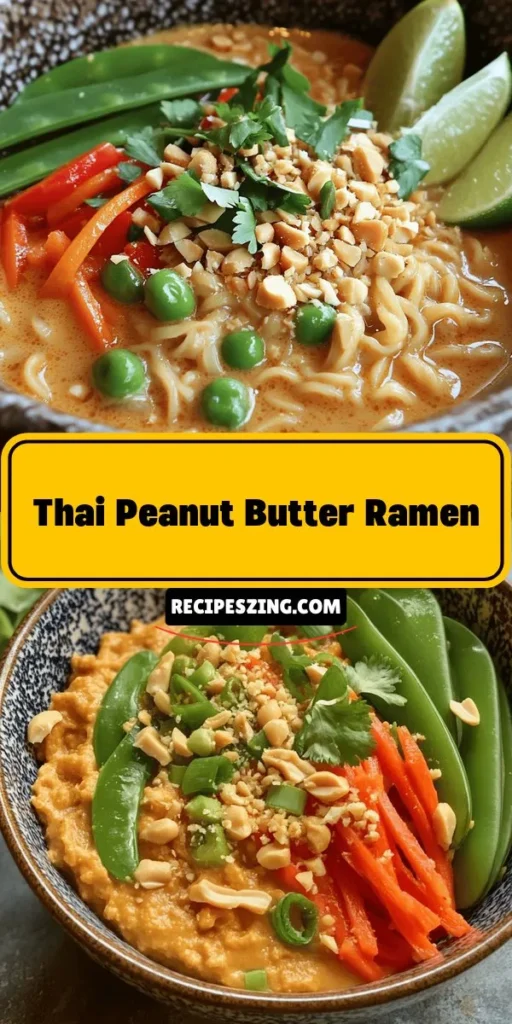Introduction
Thai cuisine is celebrated worldwide for its vibrant flavors, aromatic herbs, and balanced use of spices. The essence of Thai cooking lies in its ability to harmonize sweet, sour, salty, and spicy elements, creating dishes that are as complex as they are comforting. One such dish that has gained popularity among food enthusiasts and home cooks alike is Thai Peanut Butter Ramen. This innovative twist on traditional ramen combines the rich and creamy texture of peanut butter with the umami depth of ramen noodles, resulting in a dish that’s perfect for any occasion.
The appeal of Thai Peanut Butter Ramen lies not only in its delightful taste but also in its simplicity. It’s a quick and easy recipe that can be prepared in under 30 minutes, making it an ideal meal for busy weeknights. Packed with flavor and nutrients, this dish provides a satisfying experience, whether you are a seasoned cook or a beginner in the kitchen. As we delve into the details of this recipe, you will discover how to create a bowl of ramen that bursts with authentic Thai flavors, all while being simple to prepare.
Understanding the Ingredients
Creating a delicious bowl of Thai Peanut Butter Ramen starts with understanding the key ingredients that contribute to its unique flavor profile. Each component plays a crucial role in crafting a dish that is both satisfying and nourishing.
Ramen Noodles
Ramen noodles are the backbone of this dish. They come in various forms, including fresh, dried, or instant. When selecting noodles, fresh or dried ramen is preferred for its authentic texture and taste. To achieve the perfect consistency, follow the cooking instructions on the package, but be mindful not to overcook them. Al dente ramen provides a delightful chewiness that complements the creamy peanut sauce beautifully.
Vegetable Broth
The choice of broth is essential for enhancing the flavor of your ramen. A quality vegetable broth serves as a flavorful base for the dish. It adds depth and richness that pairs well with the peanut sauce. If you’re looking for alternatives, homemade vegetable stock can elevate the taste even further, or you can opt for low-sodium options to better control the saltiness of your meal.
Peanut Butter
Peanut butter is the star ingredient in this recipe, lending its creamy texture and nutty flavor to the dish. When selecting peanut butter, choose a natural variety without added sugars or oils for the best results. The right peanut butter will create a smooth and luscious sauce that envelops the ramen and vegetables, ensuring each bite is packed with flavor.
Soy Sauce
Soy sauce is another vital ingredient in this recipe. It enhances the umami flavor and adds a salty component that balances the sweetness of the peanut butter and maple syrup or honey. For the best flavor, opt for high-quality soy sauce or tamari if you’re looking for a gluten-free option. This small choice can significantly impact the overall taste of your dish.
Lime Juice
Lime juice adds a refreshing acidity that brightens the flavors and cuts through the richness of the peanut butter. The citrus notes help balance the dish, making it more enjoyable and complex. Freshly squeezed lime juice is always preferred, as it provides a fresher taste compared to bottled alternatives.
Maple Syrup or Honey
To achieve a perfect balance of flavors, a touch of sweetness is necessary. Maple syrup or honey can be used to naturally sweeten the sauce without overpowering the other flavors. Depending on your preference, you can adjust the quantity to suit your taste, making the dish as sweet or savory as you like.
Sesame Oil
Sesame oil adds a rich, nutty flavor that enhances the overall taste of the ramen. A small drizzle can go a long way in providing depth. Use toasted sesame oil for a more pronounced flavor, which will complement the peanut butter and other ingredients beautifully.
Grated Ginger and Minced Garlic
Aromatics such as grated ginger and minced garlic are essential for elevating the dish. Ginger provides a warm, spicy note, while garlic adds depth and richness. Together, they create a fragrant base that enhances the overall flavor profile of the ramen.
Fresh Vegetables
Incorporating fresh vegetables not only adds color and texture to the dish but also offers nutritional benefits. Vegetables such as bell peppers, carrots, and baby spinach are excellent choices, contributing vitamins and minerals to the meal. Their vibrant colors also make the dish visually appealing, inviting you to indulge in a delightful culinary experience.
Step-by-Step Cooking Process
Now that we have a clear understanding of the ingredients, let’s dive into the step-by-step process for preparing Thai Peanut Butter Ramen. This detailed guide will ensure you achieve a delicious bowl of ramen every time.
Cooking the Ramen
1. Prepare the Noodles: Begin by bringing a large pot of water to a boil. Add the ramen noodles and cook according to the package instructions. It’s important to keep an eye on the timing; overcooked noodles can become mushy and lose their desirable texture. Aim for a firm, al dente finish.
2. Drain and Rinse: Once the noodles are cooked, drain them in a colander and rinse under cold water to stop the cooking process. This step also helps remove excess starch, preventing the noodles from becoming sticky.
Making the Peanut Sauce
3. Combine Ingredients: While the noodles are cooking, you can prepare the peanut sauce. In a medium bowl, combine the peanut butter, soy sauce, lime juice, maple syrup (or honey), and sesame oil.
4. Add Aromatics: Grate a small piece of fresh ginger and mince a couple of garlic cloves, adding them to the sauce mixture. These ingredients will infuse the sauce with aromatic flavors.
5. Mix Until Smooth: Use a whisk or fork to mix the ingredients until you achieve a smooth, creamy consistency. If the sauce is too thick, you can add a splash of vegetable broth or water to reach your desired texture. The goal is to create a sauce that is pourable but still thick enough to coat the noodles.
Assembling the Dish
6. Heat the Broth: In a separate pot, heat your vegetable broth over medium heat until it reaches a gentle simmer. This will serve as the base for serving your ramen.
7. Combine and Serve: In large serving bowls, add a portion of the cooked ramen noodles. Pour the hot vegetable broth over the noodles, followed by generous amounts of the peanut sauce. Toss everything gently to combine.
8. Add Fresh Vegetables: Finally, top your ramen with a mix of fresh vegetables. Consider adding raw or lightly sautéed bell peppers, shredded carrots, and baby spinach. These will not only enhance the flavor but also provide a crunch that contrasts with the creamy noodles.
By following these detailed instructions, you can create a delicious and fulfilling bowl of Thai Peanut Butter Ramen that showcases the best of Thai cuisine. Each step allows you to appreciate the individual flavors while harmonizing them into a delightful culinary experience that is sure to impress. In the next part of this article, we will explore additional tips for achieving the best results and address common questions about this delectable dish.

Sautéing the Vegetables: Maintaining Vibrant Colors and Nutrients
To create a visually appealing and nutritious dish, sautéing the vegetables correctly is essential. Start by heating a tablespoon of oil in a large skillet or wok over medium-high heat. Once the oil is shimmering, add your chopped vegetables—bell peppers, carrots, broccoli, and snap peas are excellent choices. Stir-fry these colorful vegetables for about 3-5 minutes, ensuring they remain crisp and vibrant.
The goal is to cook them just enough to soften slightly while preserving their bright colors and nutrients. Overcooking can lead to dull colors and loss of vitamins, so keep a close eye on the texture. If you prefer a bit of char, increase the heat for the last minute of cooking. This technique not only enhances the flavor but also adds a delightful complexity to the dish.
Combining All Ingredients: Techniques for Even Coating of Sauce
Once your vegetables are perfectly sautéed, it’s time to bring everything together. Begin by lowering the heat to medium and adding the cooked ramen noodles to the skillet. Pour your prepared peanut sauce over the noodles and vegetables, ensuring an even distribution. For optimal mixing, use tongs or a pair of chopsticks to gently toss the ingredients together. This method allows the sauce to coat every strand of noodle and piece of vegetable evenly, enhancing the flavor in every bite.
If you find the sauce too thick, feel free to add a splash of vegetable broth or water to loosen it up. Keep tossing until everything is well combined and heated through—this should take about 2-3 minutes. Taste and adjust the seasoning, adding more soy sauce, lime juice, or chili flakes according to your preference.
Serving Suggestions: Presentation Tips for an Inviting Dish
Presentation plays a crucial role in making your meal appetizing. Once combined, transfer the Thai Peanut Butter Ramen to a large serving bowl or individual plates. Garnish with a sprinkle of chopped green onions, sesame seeds, and crushed peanuts for added texture and flavor. For a pop of color, add a few cilantro leaves or a wedge of lime on the side.
To elevate your dining experience, consider serving the ramen alongside a fresh cucumber salad dressed with rice vinegar and a touch of sesame oil. This adds a refreshing contrast to the richness of the peanut sauce. Enjoy your meal warm, and don’t forget to take a moment to appreciate the beautiful colors and textures on your plate!
Nutritional Analysis
This Thai Peanut Butter Ramen is not only delicious, but it’s also packed with nutrients. Here’s a breakdown of the nutritional values per serving:
– Calories: Approximately 450
– Protein: 15 grams
– Carbohydrates: 60 grams
– Fats: 20 grams
Health Benefits of Key Ingredients
– Peanut Butter: Rich in protein and healthy fats, peanut butter provides energy and helps to maintain muscle mass. It also contains magnesium, which supports heart health.
– Vegetables: The array of vegetables adds vitamins A, C, and K, along with important antioxidants that help reduce inflammation and support overall health.
– Noodles: Depending on the type of noodles used, they can provide energy-boosting carbohydrates as well as fiber, especially if you opt for whole grain or vegetable-based options.
Discussion on Dietary Considerations
This recipe can easily be modified to suit various dietary needs. For a vegan option, ensure you use a plant-based peanut butter and vegetable broth. If you are gluten-sensitive, substitute traditional noodles with gluten-free rice noodles or zucchini noodles (zoodles). This flexibility makes it a great meal for anyone looking to enjoy a hearty bowl of ramen without compromising their dietary preferences.
Flavor Variations and Customizations
One of the best aspects of this Thai Peanut Butter Ramen is its versatility. Here are some suggestions for ingredient substitutions based on dietary preferences:
– Alternative Noodles: While traditional egg noodles are commonly used, rice noodles make for a gluten-free option. For a low-carb alternative, consider zoodles or shirataki noodles, which absorb the flavors of the sauce beautifully.
– Different Types of Nut Butters: If you’re looking to experiment with flavors, try using almond butter, cashew butter, or sunflower seed butter. Each nut butter offers a unique taste profile and can be a fun twist on the original recipe.
– Vegetable Swaps: Seasonal vegetables can add freshness and variety to your ramen. Consider using asparagus, bok choy, or even spinach, depending on what’s available. Mixing in a variety of colors and textures will make your dish even more appealing.
– Adding Protein: For those looking to add a protein boost, grilled chicken, shrimp, or tofu are excellent options. Simply cook the protein of your choice separately and toss it in with the noodles and vegetables before serving.
Cultural Significance of Peanut Sauce in Thai Cuisine
Peanut sauce holds a special place in Thai cuisine, often served with satay or as a dipping sauce. Its origins can be traced back to the influences of Indonesian and Malay cooking, where peanuts are abundant. In Thailand, the sauce is enjoyed in various forms, typically blended with coconut milk, tamarind, and spices to create a rich, savory flavor.
This Thai Peanut Butter Ramen embodies traditional Thai flavors while providing a contemporary twist that is both accessible and easy to prepare. By combining the creamy texture of peanut butter with fresh vegetables and noodles, this recipe brings a taste of Thailand to your kitchen, making it a delightful experience for both novice and seasoned cooks.
Conclusion
Thai Peanut Butter Ramen is a vibrant and satisfying dish that combines the rich flavors of peanut sauce with fresh vegetables and tender noodles. Its health benefits, versatility, and ease of preparation make it an excellent choice for a quick weeknight dinner or a comforting weekend meal.
We encourage you to try this recipe and personalize it to your liking. Whether you stick to the traditional ingredients or venture into creative substitutions, the joy of cooking and discovering new flavors awaits. Enjoy the process, and savor each bite of this delightful dish!



